Best Manufacturing ERP: Top 6 Software Solutions in 2024
When choosing a new manufacturing ERP system, companies are making an investment in a product with a long life cycle. That is why the selection process needs to consist of a lot of comparisons and analyses. Here are the best manufacturing ERP systems available for small manufacturers.
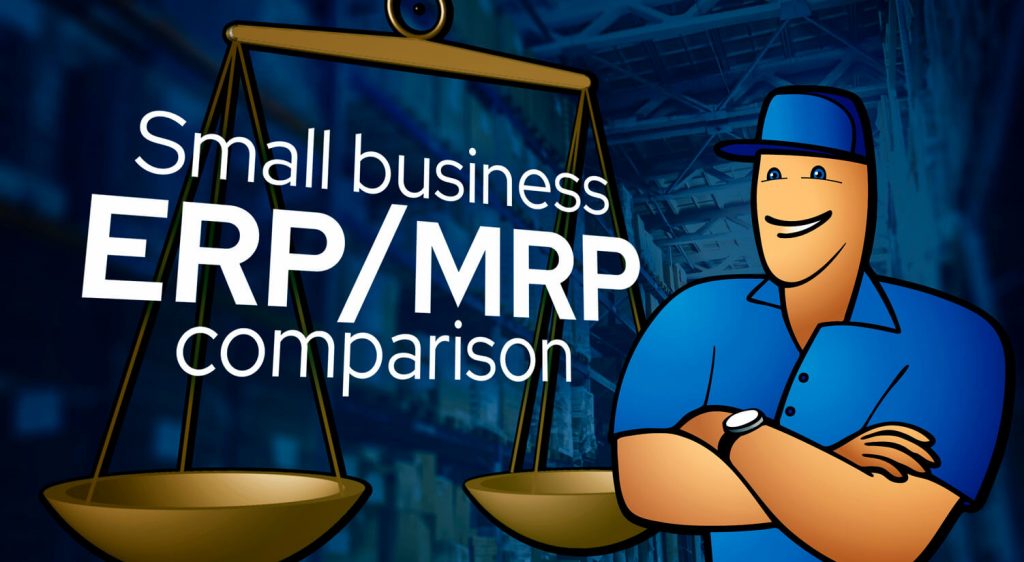
You can also listen to this article:
Intro
Choosing new software can be difficult for any business. In addition to the cost, founders and decision-makers must research the software’s reputation, assess its capabilities across a wide range of desired functionality, and choose a solution that will meet company needs without having an enormous learning curve.
They must also choose between cloud-based vs. hosted options and ensure that they purchase a balance of licensed seats for the right mix of users.
For large enterprises, much of the groundwork can be done by in-house IT staff while the cost is spread over a large product base to minimize the impact on the company. But for small manufacturing companies with 10-200 employees, these challenges are magnified.
Smaller companies are often at a disadvantage and IT professionals may not be on staff. Additionally, the extensive capital outlay for new systems may not be feasible for smaller manufacturers. As a result, the business owner or decision-maker risks choosing a system that is too weak or too strong, or one that has such a deep learning curve for already overtaxed staff that full functionality may never be realized.
If these challenges are real for the selection of any critical software, it is especially true when a company reaches scale and complexity and finds itself in need of a robust, right-sized ERP system. And if the challenges exist for selecting critical software for a singular functional area, then those challenges multiply for an important decision involving a software system that will drive most, and in some cases all, of a company’s core business functions for many years.
MRP systems and ERP systems
To make the best choice among existing platforms, it is best to first understand the difference between an MRP and an ERP. An MRP, or Manufacturing Resources Planning system, is a production-focused control system that encompasses production planning, scheduling, and inventory of components, raw materials, and other parts or assemblies required to produce finished goods. Specifically, an MRP system ensures that material and equipment are available for production and allows for the planning of any associated purchasing.
An ERP, or Enterprise Resource Planning System, has all the elements of an MRP for production, shop floor control, and purchasing; but it also provides systemized management and data analysis for financial and sales functions, all optimized for a manufacturing environment. An ERP system will include financial integration of functions such as Accounts Payable and Accounts Receivable, Customer Relationship Management (CRM), fixed asset monitoring, and other key administrative and financial functions. This allows for the integration and management of all company functions and leverages automation and real-time data analysis to improve the performance of the company.
Benefits of ERP systems for small enterprises
There are many benefits to implementing an ERP system for a small company. For one, the company may need to replace an older system or one that was manually managed since the early days. Many small businesses often use cobbled-together systems or legacy applications brought over by staff from previous jobs. An ERP system can replace an older system with increased functionality and analytics to allow accurate and best-practice materials management throughout the company.
Secondly, an ERP system can eliminate “fragmentation”. Fragmentation occurs when a company uses numerous software systems from department to department to accomplish the initial growth experienced by the enterprise. The problem arises when the company scales and product offerings and manufacturing volume begin to exceed the combination of different systems’ capabilities for providing organization and control of production processes as well as back-office functions.
In many cases, fragmented software systems may not integrate with one another, and reporting between the systems may have to be manually reconciled. As manufacturing volume increases, an ERP system can eliminate fragmentation, integrating the material and business controls into a single platform with real-time data and analytics.
Finally, a company may have diversified its product line with new and more complex iterations that explode the associated bill of materials required to produce. This bogs down the planning and purchasing required to feed the bill of materials and introduces inefficiency into the operation that extends throughout the manufacturing process. An ERP system can process the data and provide clear, organized, and automated functionality to manage core business functions and operate manufacturing efficiently and with the right level of material availability.
Top 6 manufacturing ERP systems
Regardless of a company’s reason for pursuing an ERP system, today there are a variety of options available for almost any industry and for companies of varying size and complexity. Tier I ERP providers such as SAP and Oracle have traditionally serviced companies with revenues above $200 million, although SAP now has a version for small to medium-sized businesses as well. Tier II ERP systems generally service enterprises with $20-$200 million in sales and less than 200 users. Tier III ERP systems generally focus on companies with under $40 million and with 5-30 users. To help choose the right ERP system for a growing small manufacturer, here is a look at the Top 6 Tier II and Tier III ERP providers available today for small manufacturers.
Epicor
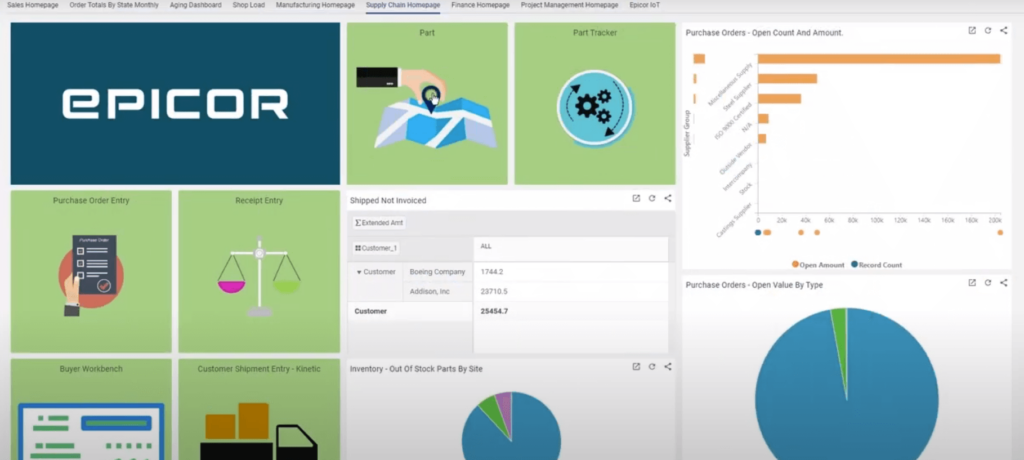
This Tier II provider offers a platform for any manufacturer with over $1 million in revenue. It is also flexible in that the core functionality of the basic ERP can be augmented through the purchase of additional modules a la carte. This provides companies with the option of purchasing only what they need with the flexibility of adding additional modules later. Epicor offers production management, supply chain management, and scheduling as well as financial management. The platform offers manufacturers the ability to utilize make-to-order, configure-to-order, and make-to-stock shop floor control and manage it all within the out-of-the-box software functionality. The system is easy to customize and scalable. It is also compatible with all mobile devices.
Epicor also offers a Quality Performance Management (QPM) module that is not often found in other ERP systems. This type of module is often only obtainable through ISVs (Independent Software Vendors) in competing vendor platforms.
Some downsides include a common complaint about slow customer support. It also has limited flexibility in invoicing and order modifications and does not offer any standard integrations but does have an open API on demand. It also has a very limited import and export functionality, an oddity given that Microsoft import/export capability is available in most of its common products. In the case of Epicor, import/export can be done only through the purchase of an ISV add-on.
The system can be delivered on-premise, hosted, or as a cloud-based SaaS application. While Epicor does not disclose pricing, estimates are around $175 per user per month after implementation costs.
MRPeasy
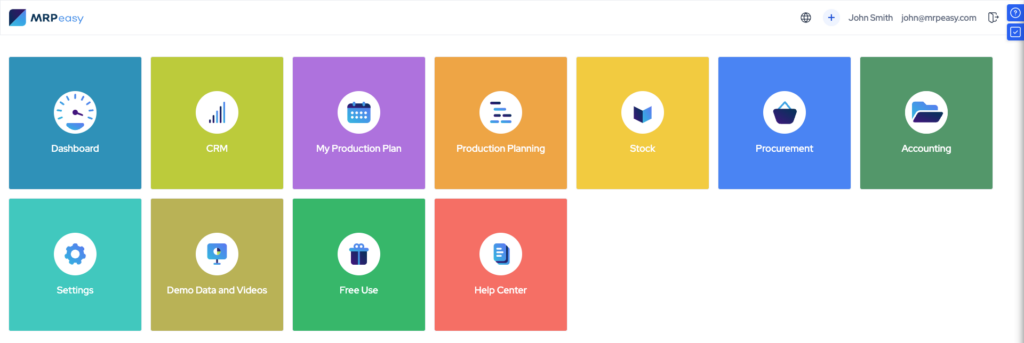
This Tier II and Tier III provider on the list is also the one with the lowest cost. MRPeasy’s ERP platform was originally built as an MRP system. Its core functionality included manufacturing, shop floor control, material planning, inventory, sales order management, warehouse management, and work order management. But as the strength of its core product became apparent, MRPeasy has moved on to become a full ERP system with the lowest cost within the Tier II and Tier III space.
MRPeasy accomplishes its transition to a full ERP product in a very clever way – by making the most of integrations with 3rd party software. For example, MRPeasy has designed its new ERP platform to integrate with both Xero and QuickBooks, with e-commerce platforms such as Shopify, WooCommerce, and BigCommerce, with Pipedrive CRM, with fulfillment platforms such as Ware2Go and ShipStation, and with the integration hub Zapier.
See a list of all MRPeasy integrations.
All of those applications are used extensively by small and medium-sized companies worldwide as their software of choice. By integrating their core MRP functionality with top-level accounting, CRM, and fulfillment platforms, MRPeasy can offer a fully functional ERP solution for small to medium-sized companies with 10-200 employees.
MRPeasy looks especially good when weighing its extensive functionality against its price. When it comes to manufacturing, the software is lauded for the traceability it provides for heavily regulated industries such as food and pharma.
The interface is very clean and modern, with no clutter whatsoever. The already great production scheduling capability is perfected with Gantt charts and drag-and-drop rescheduling. All of the modules are seamlessly connected so that a late delivery from a supplier reflects immediately in the production schedule and the CRM. The system also has a product configurator (Matrix BOM) and multi-level BOM functionalities that are great for companies that produce variants of the same product or complex products with many subassemblies. The RMA module within the system allows users to easily manage product returns, repairs, and recalls.
The system requires no installation as it is exclusively public-cloud-based. It also offers very high-level information and support materials on its webpage in the form of instructional videos, user manuals, FAQs, and other tools designed to streamline the learning curve required for implementation. Thanks to this easily understandable information, most of the software’s users are able to implement it without the help of external consultants.
The integration with Xero, QuickBooks, Pipedrive, and Zapier also lends immediate credibility to the integrated functions due to the partner’s name recognition and reputation. It also means that MRPeasy could leapfrog over the kind of software development bugs and glitches other suppliers encounter when making the transition to a higher-functioning iteration. The system also works on mobile devices, including Android and iOS. As it is browser-based, the users never need to perform system maintenance or update the software.
While there are Starter and Professional packages available at $49 and $69 per user per month for the first ten users respectively, the most popular is the Enterprise version at $99 per user per month. An additional Unlimited level is available for $149 per user per month that has the same features as Enterprise but with no built-in limits and with an added API capability.
The software’s prices beyond the first ten users are greatly reduced (only $79 per group of 10 users), meaning that adding users as the company scales brings the average cost per user down even further.
Microsoft Dynamics 365 Business Central
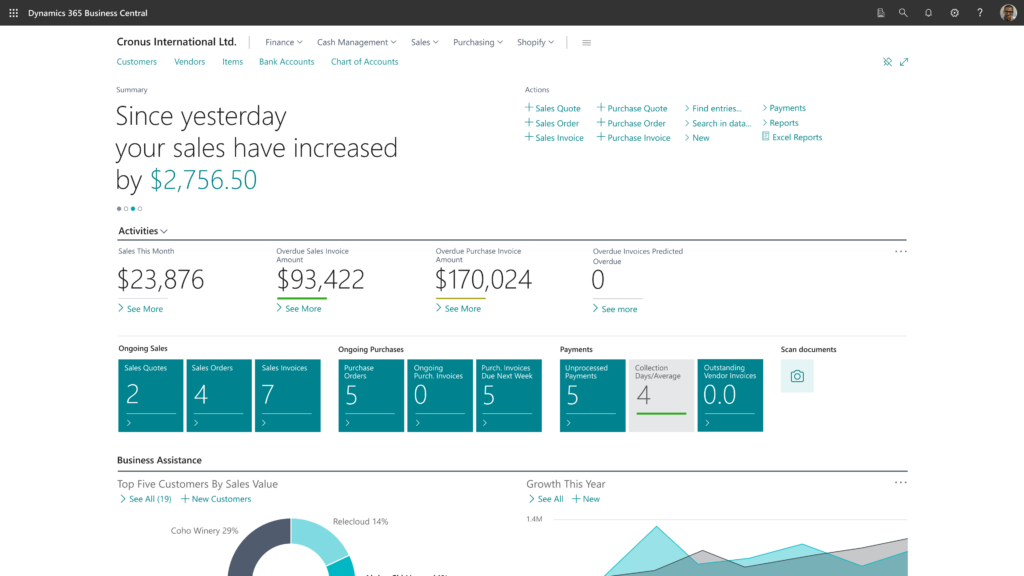
This Tier II provider is often included in Tier I as many companies are giving it a look for use within larger enterprises. Microsoft Dynamics 365 Business Central offers the name recognition of Microsoft along with a strong ERP platform that includes operations, financial accounting, project management, CRM, and purchasing. It also offers a field service option for companies that have extensive field technician operations and wish to integrate those actions into the managed ERP platform.
While Business Central does have considerable core functionality out of the box, it may require the utilization of ISVs for specific workflow programming needs. And for companies with complex processes, these ISV add-ons can add considerable cost to implementation. However, it is a strong product and has the ability to be customized for each customer.
Negatives include editing limitations among several modules and patchy integration with some external applications by 3rd party providers. And while it can be customized for many industries it might take a lot of time to get used to. Business Central ERP implementation also requires that adopting companies partner with a certified partner company for programming and deployment. This adds cost and places the adopting company one step removed from the actual provider.
Microsoft Dynamics 365 Business Central is deployable both on-premise and as a cloud-based application and can be hosted on Microsoft’s own cloud platform. Business Central can be purchased as a one-time payment or as a subscription. Cost per user after infrastructure and implementation costs is $70 per user per month for the Essentials plan and $100 for the Premium plan. It is important to note that implementation costs for Business Central could go into tens of thousands of dollars.
Rootstock
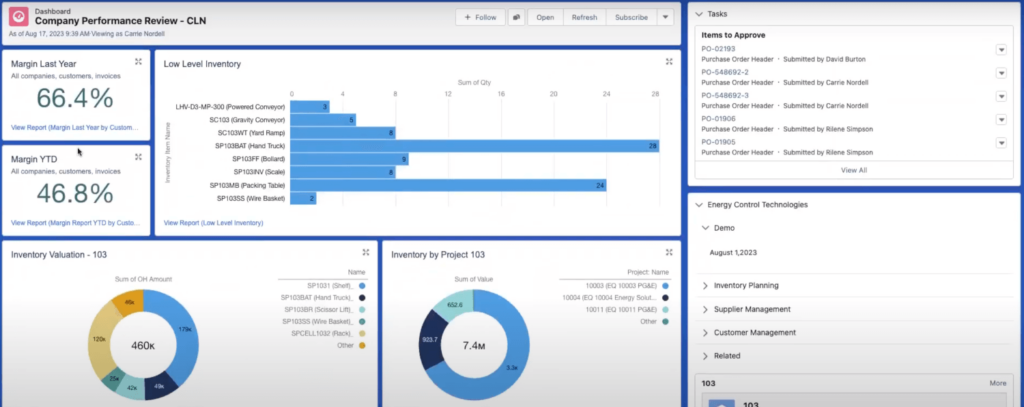
Another Tier II ERP supplier, Rootstock offers an ERP system to manufacturers. It is built on the Salesforce platform, allowing it to leverage powerful cloud options and superior integration among applications, a problem that often plagues other systems.
Rootstock offers production scheduling and capacity scheduling, shop floor control, inventory, purchasing, and financials, as do most ERP systems. But Rootstock also offers engineering change management, sales order management, services, and returns and repairs. This broader selection of options can then be used to add applications and solutions from within the Salesforce ecosystem to customize and focus needs for specific industries.
Rootstock has additional modules for CAD and engineering allowing them to handle designs for electronics, electrical and mechanical functions. Work order routings can be modified without disruption to standard routings giving shop floor management the ability to customize production orders without the headaches usually brought on by special requests and customized production. The system also has strong costing capabilities from the micro through the macro level. In all its maturity, customers report great user-friendliness.
Some negatives for the platform have included slow customer support and scant documentation for products. Rootstock has, however, made great strides to improve its customer service and its more recent online reviews are a reflection of that. However, mobile applications that are common with many competitors offering similar platforms can only be obtained through an expensive add-on. Also, some common features within the finance module are missing, challenging its strength as a complete ERP. It does integrate with 3rd party accounting applications such as Quickbooks.
The system is delivered as a SaaS on the Salesforce Cloud Platform. Prices start at $200, plus implementation costs.
Syspro
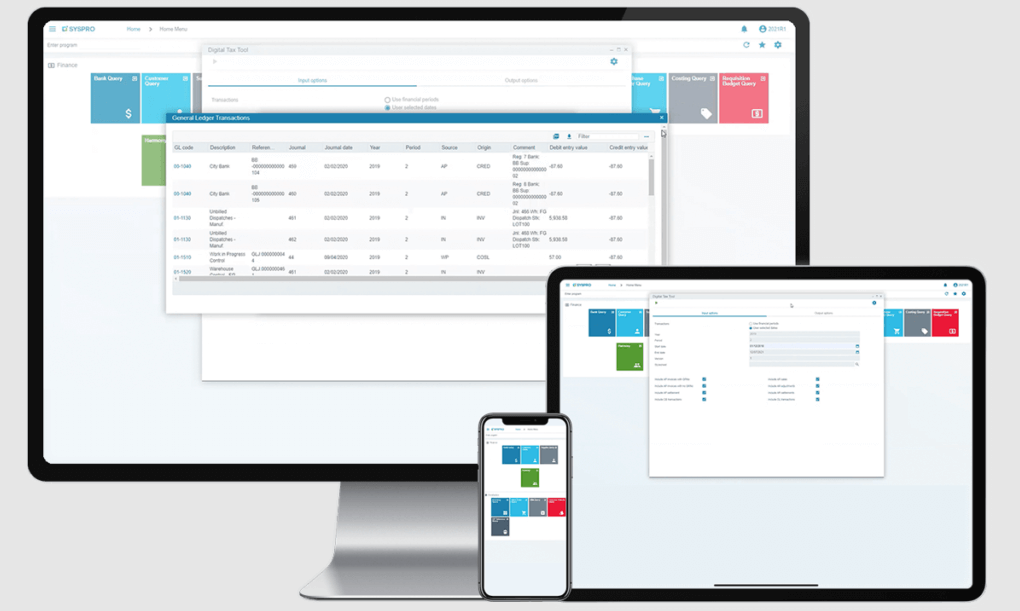
Syspro manufacturing software offers ERP functionality that can be tailored to the scale of the enterprise. This Tier III provider also offers a modular system and additional modules can be added later as the company grows. Syspro has the base elements common to small ERP systems such as shop floor control, inventory control, and finance functions. Syspro also has a strong scheduling functionality that allows it to utilize single-constraint as well as multi-constraint scheduling. This allows the system to track actual vs estimated labor and manage materials and scrap for work-in-process. This is a valuable tool for smaller manufacturers where material costs can make a big impact on profit. The system also has Engineering Change Control (ECC) so users can track and manage changes to versions in production.
The platform has improved its user interface and has multiple visual tools to connect master data throughout an enterprise. It also has a unified system for mixed-mode manufacturing, another important consideration for smaller manufacturers looking to optimize and track their production processes.
For all the sophistication within its core manufacturing functionality, there are some negatives related to reporting and data management. The out-of-the-box reports are not useful and must be redone to suit the individual company and there are limitations on how much customization can be done. Data between key areas such as inventory and AR must be in the same cost period to ensure accuracy. This limits some data analysis and forces users to be vigilant where other providers handle the issue seamlessly. Users have also complained about the complicated interface and the support team’s response times going into weeks.
Syspro is available through the cloud as a SaaS or on-premise. It is sold primarily through resellers and pricing is around $199 per user per month after installation costs. Basic on-premise installation starts at $12,000.
DelmiaWORKS (IQMS)
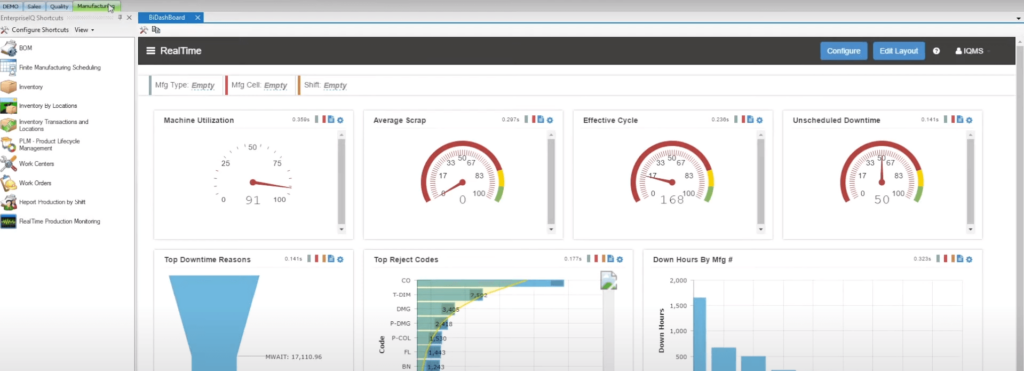
Another Tier III provider, DELMIAworks (formerly known as IQMS) is a modular provider offering manufacturing companies the option of adding capabilities with additional models as they scale. Core functionality includes manufacturing and resource planning, scheduling, supply chain, CRM, purchasing, and accounting.
Two strong features in the DELMIAworks ERP system not commonly offered among competitors provide key benefits to small manufacturers. These two features are Vendor Managed Inventory (VMI) and embedded Electronic Data Interchange. VMI allows the manufacturer to manage inventory on the customer end opening the company to consignment-style arrangements as well as assuring Just-in-Time capability by placing visibility further upstream into the vendor’s warehouse. The embedded EDI feature allows for the development of seamless automation in purchasing from point of order through the delivery of raw materials and key components. These features make DELMIAworks a good choice for companies attempting to build lean best practices into their purchasing process.
Among the negatives are limited drill-downs for inventory analysis, a deficiency that would seem to offset some of the benefits of VMI. The reporting capabilities of DELMIAworks are very limited throughout the system. There have also been issues with software bugs and limited functionality on modules such as Time and Attendance. Finally, the system does not connect work orders to sales orders meaning the chain from end to end is not seamless. Customers have said that if basic supply chain functionality is a requirement, then DELMIAworks is not the best option.
The system is available through the cloud or as a SaaS on-premise. Pricing for DELMIAworks ERP is notoriously difficult to determine. However, price ranges online have reached as high as estimates of $45,000 USD for annual cost and $3,000 USD per user per month.
Choosing the right software
ERP implementation is tedious, time-consuming, and expensive. By choosing a new ERP platform, a manufacturing company is investing in a product with a long lifecycle, possibly longer than any manufacturing equipment.
If the choices are balanced, the company can reap the benefits of increased efficiency and improved customer service. If the wrong system is selected, the company can incur costs instead.
For small and medium-sized companies, capital expenditures can be especially critical, since user costs are only part of the equation. Over the lifetime of the ERP, there will also be additional costs in the form of data entry, training, software updates, maintenance, support, and other potential cost minefields.
It is imperative that owners and decision-makers tasked with the decision of purchasing a new ERP do so with a balance of cost, ease of use, lifecycle changes, and especially, the unique needs of their company within their industry.
You may also like: Software for Manufacturing Business – What to Look for?




